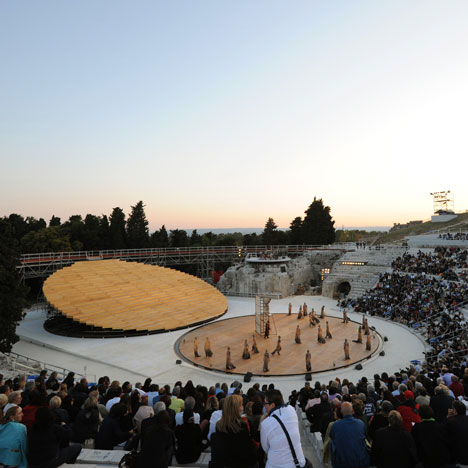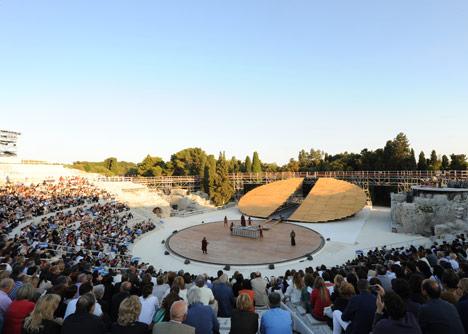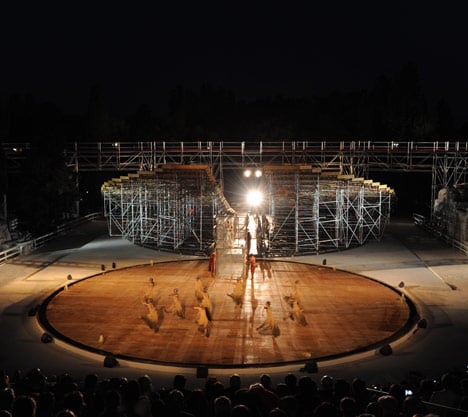Stage set at the Greek Theatre in Syracuse by OMA
Slideshow: OMA have created a stage set for an ancient outdoor theatre in Sicily that dates back to the fifth century BC.

A circular wooden platform provides the main stage, while the backdrop is a seven-metre-high tilted disc that can spin around or split down the middle. A ring of scaffolding completes the circle of the tiered amphitheatre to form an elevated walkway behing the stage.

The set will remain in place throughout the summer and was inaugurated on Friday with a performance of ancient Greek play Prometheus Unbound.

OMA have unveiled a few new projects in the last month, including a performance institute in New York and an arts venue in Moscow. Rem Koolhaas gave Dezeen a quick introduction to that project, which you can watch here.
An exhibition documenting the working processes of the firm also took place at the end of 2011 at the Barbican Art Gallery in London, where we filmed a series of movies with OMA partners Koolhaas, Reinier de Graaf and Iyad Alsaka. Watch the series here.
Photography is by Alberto Moncada.
Here's some more information from the architects:
OMA designs stage set for ancient Greek theatre in Syracuse
OMA’s design for the stage set at the Greek Theatre in Syracuse, Sicily, was inaugurated with the performance of Aeschylus’s Prometheus Unbound (directed by Claudio Longhi). The scenography features three temporary architectural devices that reinterpret the spaces of the theatre, which dates from the 5th century BC.
OMA’s interventions will be dramatically exploited and adapted at strategic moments within this summer’s cycle of plays staged by the Istituto Nazionale del Dramma Antico, which also includes Euripides’ Bacchae (dir. Antonio Calenda) and Aristophane’s The Birds (dir. Roberta Torre).
The first intervention, the Ring, is a suspended walkway that completes the semi-circle of the terraced seating, encompassing the stage and the backstage, and giving actors an alternative way of entering the scene.
The Machine is a fully adaptable backdrop for the plays: a sloping circular platform, seven metres high, mirroring the amphitheatre. The backdrop can rotate, symbolizing the passage of 13 centuries during Prometheus’s torture; split down the middle, it can also be opened, allowing the entrance of the actors, and symbolizing dramatic events like the Prometheus being swallowed in the bowels of the earth.
The Raft, a circular stage for the actors and dancers, reimagines the orchestra space as a modern thymele, the altar that in ancient times was dedicated to Dionysian rites.
The Greek Theatre scenography – executed by AMO, the unit within OMA dedicated to non-architectural and transient projects – is part of the office’s long history of designing innovative performance spaces, from the Netherlands Dance Theatre (1987) and the Wyly Theatre in Dallas (with Rex, 2009), to the Taipei Performing Arts Centre – three adaptable theatres plugged into a central cube, now under construction in Taiwan. AMO has also designed scenography for ephemeral events such as Prada catwalk shows and Francesco Vezzoli’s 24-Hour Museum in Paris earlier this year.